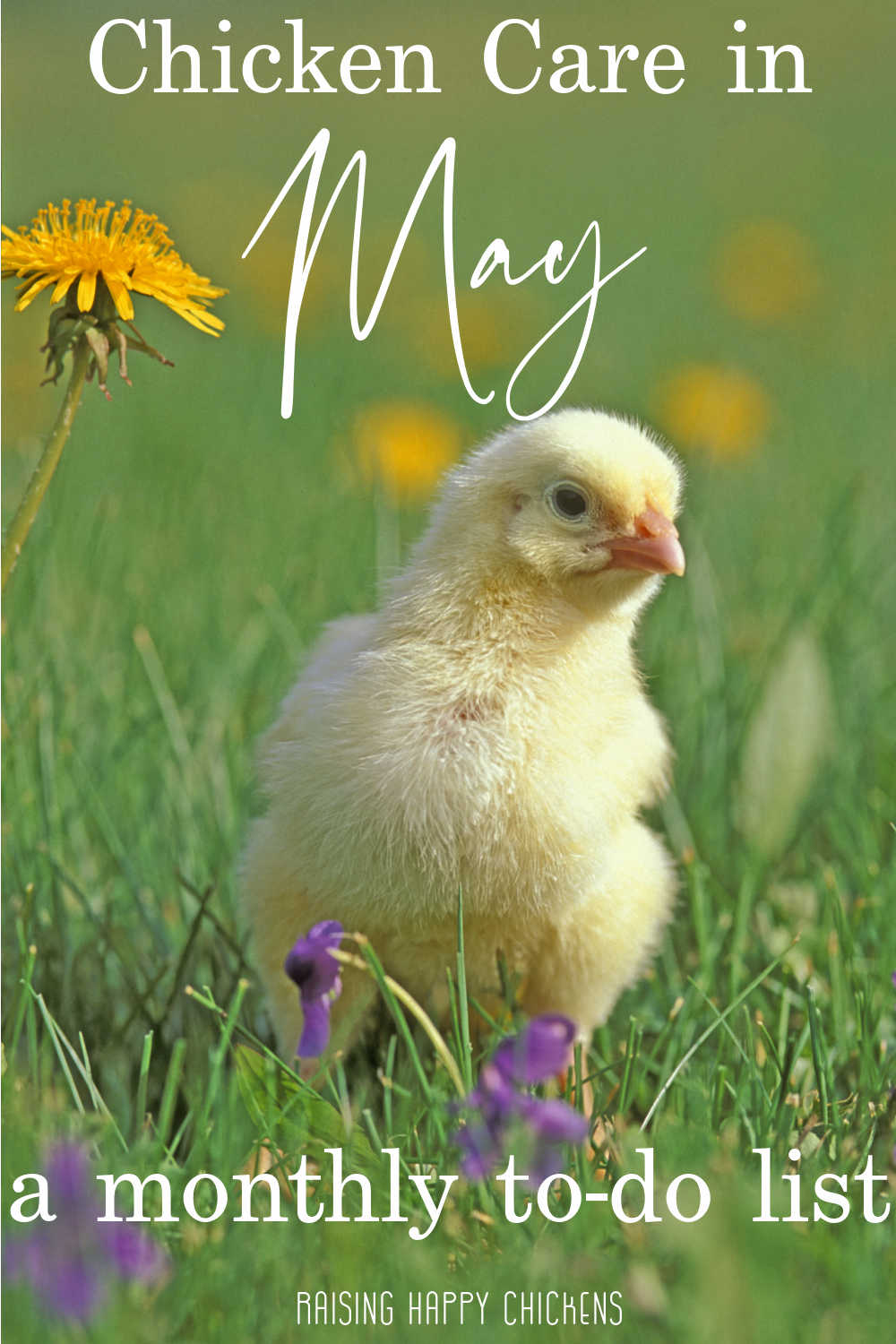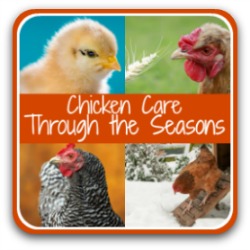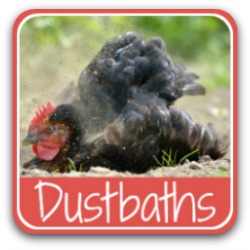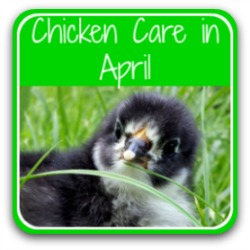- Home
- Monthly care
- May
Raising Chickens: Your Month of May To-Do List.
It's May already, baby chicks are growing bigger and chickens need dust baths!
Are you in my friendly weekly newsletter group? If so, you'll be able to download your handy checklist (or complete it online) for this month's tasks – it's a free giveaway in the "chicken digest" which comes to you on the first Monday of the month.
If you're not, why not join to get a weekly update of everything chicken-related, plus this free checklist of tasks every month?! Click here for more information.
Time to take a look at our tasks in the chicken coop for this month, whether or not you have new chicks in the flock!
1. Feeding treats to baby chicks.
So your chicks are growing, and perhaps even getting a bit bored in their brooder. They're too young to go outside yet, but you want to keep them happy and occupied.
What to do?
We all want to spoil our new baby chicks but the fact is that treats can be bad for them. Do you know how much of their daily feed should comprise of treats? Or even which treats can be harmful to them?
There are ways of both giving our chicks healthy treats, and making them interesting enough to beat the Brooder Boredom Blues.
How? Read on!
If you purchase a product through links on this page, I receive a small commission at no extra cost to you. My integrity and your satisfaction are very important to me, so I only recommend products I have purchased or would purchase myself and which I believe would benefit you. To learn more please see my affiliates disclosure document.
What to do.
1. Make sure you have a stock of a good quality starter feed before giving any other food to your chicks.
2. Chick grit must be given to baby chicks as soon as they eat anything that is not starter feed. Check out why, here.
3. Do not, under any circumstances, give your chicks oyster shell. Oyster shell and grit are two completely different things. Shells are for laying hens who need an extra supply of calcium. Giving baby chicks extra calcium will cause lasting damage.
4. Look carefully for information about what treats are best for baby chicks. Their metabolisms are different to an adult hen and need to be nurtured accordingly. This article has information about the six best chick treats you can offer.
5. It's easy to find ways of using treats which will also help your new additions beat boredom in the brooder. The "kill the swinging lettuce" game is a great way to start!
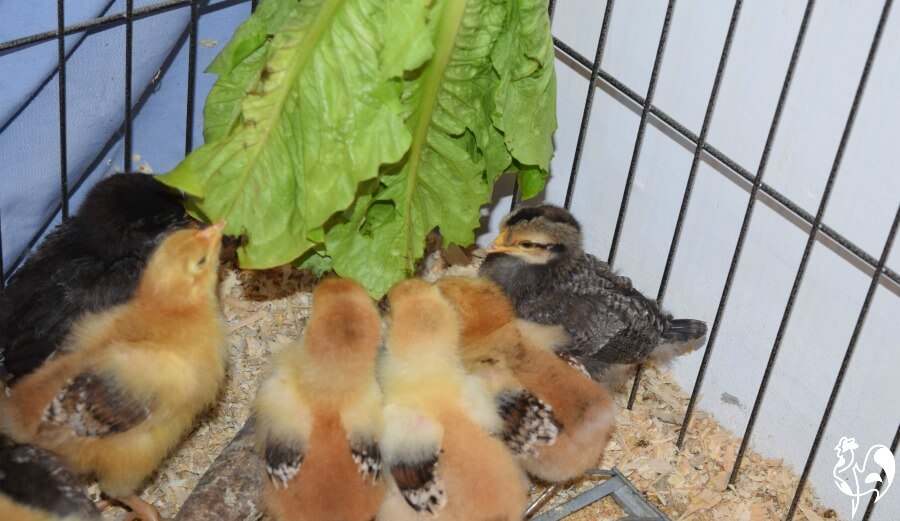 "Kill the swinging lettuce" - a favourite of my chicks.
"Kill the swinging lettuce" - a favourite of my chicks.6. Giving chicks in the brooder small amounts of short spaghetti will keep them - and you - entertained! It's not a nutritious option, but you'll find they treat it like worms...
2. Get rid of lice!
As the weather gets warmer, problems with lice and mites start to become more of an issue. We'll cover mites next month (one crawly at a time is plenty, thank you!). So this month, let's take lice ({shudder})...
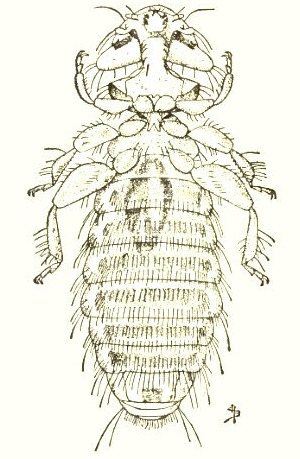
Lice reproduce very quickly and are highly contagious, spreading quickly from one chicken to another by crawling through the feathers. A bad infestation can cause death, especially in young chickens.
They live partly off the blood of their host, and will scratch around the base of chicken feathers to find an easy source(1).
They're not the same as the head lice humans sometimes get - poultry lice can't live permanently on humans or indoors.
Nevertheless, if you have an infestation in your coop you may find yourself covered in red, itchy blotches as they try their best to find a good meal on your legs.
What to do.
7. Lice are often brought into the coop by wild birds. So keep any bird feeders you have away from your chickens and as far away from the coop as possible. It's wise to do that anyway, to lessen the possibility of Bird Flu.
8. Lice are also transmitted by rodents, so make sure your coop is kept free from rats and mice. These pages have a full rundown on how to spot and prevent rodents in your coop and how to deal with them if you already have an infestation.
9. Check your flock regularly for any signs of lice. Look for clumps of eggs and dirty feathers around the vent area; ragged looking feathers or baldness which may indicate chickens trying to peck the feathers off where there's irritation; a drop in egg production; pale comb feathers. And of course those tiny, light-coloured, fast-moving bugs around the vent area.
10. Pay particular attention if you have a broody hen. They dust-bathe less often and are therefore more susceptible to lice.
11. If you discover there's any signs of lice, treat immediately - both the flock and the coop. A powder is much better to use than a spray. Make sure it contains permethrin, which will deal with a range of bugs including lice and mites.
This is one such powder which has been found to be very effective.
12. Don't rely on herbs to get rid of lice - they won't. You may not want to rely on chemicals, but once you have an infestation, it's either that or very sick, possibly even dead, chickens.
Don't risk it.
3. Dust baths, even for chicks.
Dust baths are what chickens use to keep themselves clean and free from nasties like lice and mites. Dust-bathing is also a natural behaviour for poultry: there's evidence that being unable to dust-bathe leads to behavioural problems(2).
So providing them with a dust-bathing area is vital to your flock's health.
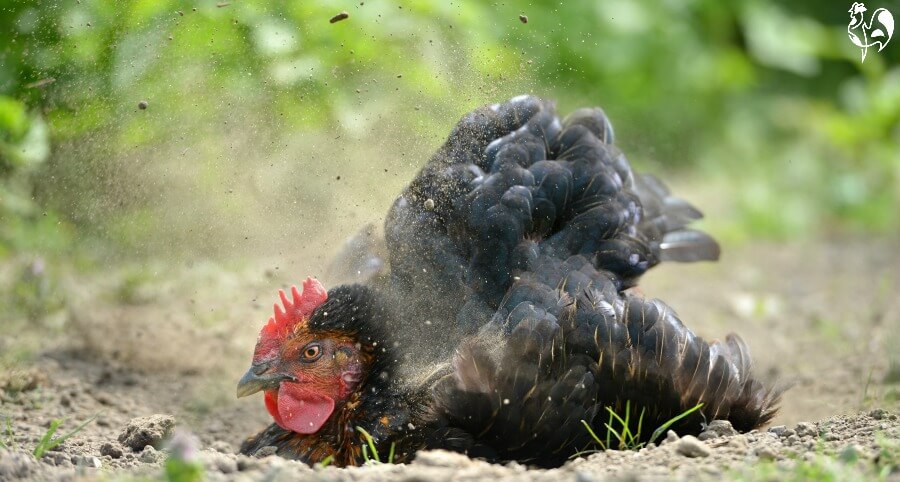 My chickens prefer to make their own dust-bath in the shade of trees.
My chickens prefer to make their own dust-bath in the shade of trees.What to do.
13. If you have a grass or dirt yard, creating a dust-bathing area is simple. Dig a hole large enough to take most of your flock at the same time (no matter how many you provide, they'll all try to get into the same one!) and either loosen the soil already there, or add a mixture of potting compost and soil. Try to place it in the shade so the chickens have somewhere to go when the sun is strong.
14. If you don't have that kind of space, re-purpose any kind of container: an old children's sandpit is a good choice. Disused car tyres look ugly but they work, as does a home-made pit made from logs, old railway sleepers or brick - whatever you have around that works.
15. What to use for the content:
Sand: - make sure it's construction grade, not play sand. I use sand in my chick brooder - chicks will dust-bathe instinctively, even at a very young age.
Soil: a good choice if yours is sandy or light.
Potting compost: chickens love this, although it's an expensive option. I use it because our soil is heavy clay.
Diatomaceous earth (DE): some people swear by this, others say it's potentially harmful to a chicken's respiratory system. I've used a small amount (a couple of handfuls) of food grade DE in my dust bath, mixed in well with compost and sand, with no apparent harmful effects. See this article for more details.
Wood ash: do not add wood ash unless you can keep the dust-bath covered when it rains. Damp wood ash creates potassium hydroxide (you may know it as lye) which can burn.
Herbs: herbs will not treat lice or mites, but they're easy to grow and if it makes you feel good to add them to your flock's spa, they certainly won't do any harm. Lavender, which is said to be a natural insect repellent, is a good choice, as are mint and rosemary.
4. Think about creating shade.
It may not be quite hot enough in your area yet to be thinking about protecting your flock from the heat, but it won't be too long before it does become an issue.
So it's wise to start thinking about it now. We'll begin by considering how to create shade.
What to do.
16. Make sure there is somewhere in your run for the flock to get shade. Trees are ideal, but it's a bit late to plant now, so make a note in your diary to buy and plant in October.
Fruit trees are best. If your climate will take it, plan for fig trees. When mature, their branches extend outwards enough to give good shade and enough space underneath for some serious dust-bathing!
And the chickens will love the fruit - mine go wild over their ripe figs!
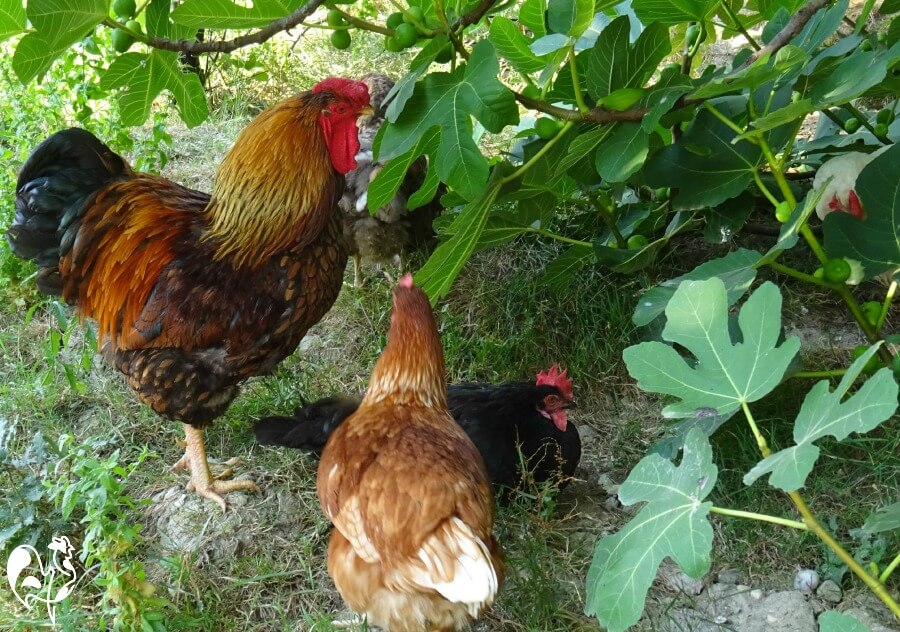 Some of my flock relax in the shade of their fig tree.
Some of my flock relax in the shade of their fig tree.17. Until then, plan to create artificial shade with something like a tarpaulin sheet or sail cloth, which is relatively inexpensive, strung across part of the run.
18. And if all else fails, dig out those beach umbrellas, check them for holes and set them aside for the chickens.
Your family may think you're slightly crazy to be thinking about the beach at this stage in the year, but your chickens will thank you for it when the hot weather comes!
5. Plant strawberries.
Creating a garden which is beneficial for your flock is not hard - even if you don't have much space.
One of the most successful plants I've found to grow is the strawberry. Planting now, before the more intense heat of the summer, will see them produce the first fruit in four to six weeks.
It's easy, inexpensive because each plant will give you more baby plants for the following year, and both baby chicks and adult chickens love eating the berries.
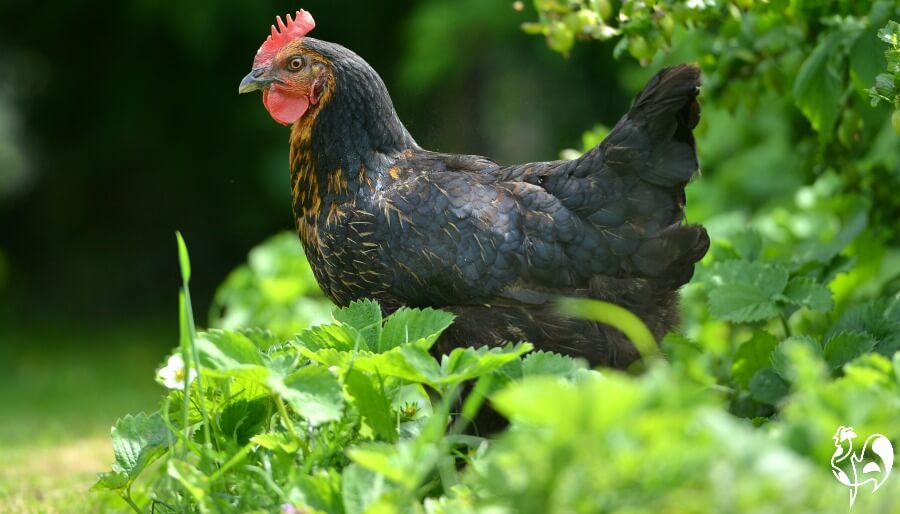 Don't let chickens into the strawberry patch if you want any left for yourself!
Don't let chickens into the strawberry patch if you want any left for yourself!Not only do they love them, the strawberry is full of nutritious goodness. With no fat, and crammed with Vitamin 'C', potassium and antioxidants, they can help your flock cope with heat stress(3), and can also help improve both fertility and mobility.(4)
Remember, though, as with all treats, they should be fed in moderation. Treats should make up no more than about 10% of your flock's diet.
What to do.
19. Plant in well drained soil and full sun, and make sure the crown of the plant is at surface level. Water in well, keep the soil or potting compost damp, and use a liquid feed every ten days or so.
When the runners develop, leave attached to the mother plant and bury the bottom of the runner in a separate pot of compost. Once the roots are established the runner attachment can be cut.
20. Planting a strawberry patch in the ground where chickens have access will mean none left for you! They'll strip it clean as soon as the fruits are ripe (and they'll avoid the leaves, instinctively).
For that reason, my flock have their own plants which I plant in hanging baskets. It adds colour and interest to the run, and the chickens can't get at the plants until I say so!
See some of my hens enjoying the first strawberries of the year!
Other people found these pages useful, too.
Sources.
A lot of "facts" you'll find on the internet are often people's individual views, and can be based on inaccurate information repeated from poor quality sources.
The information I provide in this article and others is based not just on my own experience, but on evidenced facts from scientific, peer-reviewed research and evidence from highly respected and experienced poultry keepers such as Gail Dammerow.
Some of the sources I have used in this article are these:
1. Wikipedia: Menoponidae. Pub. 2018.
2. University of Edinburgh: Chicken Behaviour and Welfare. Pub. Coursera, 2017.
3. Ahmadu, S, et al: An overview of vitamin 'C' as an anti-stress in poultry. Pub. Journal of Veterinary Research, 2016.
4. Effects of antioxidants in poultry. Pub. Biotecnologias Aplicadas, 2016.
- Home
- Monthly care
- May
